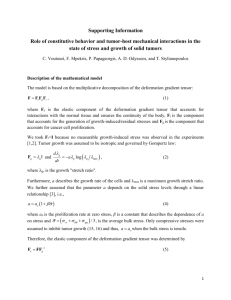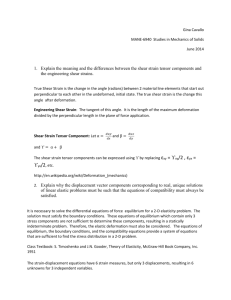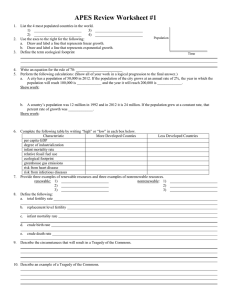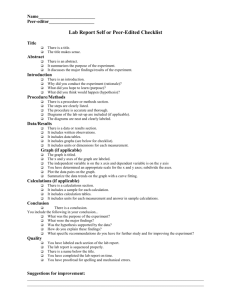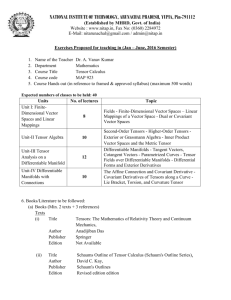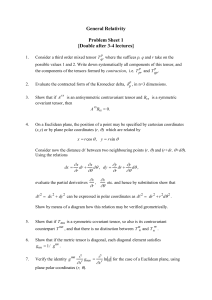Governing Equations - Florida Institute of Technology
advertisement
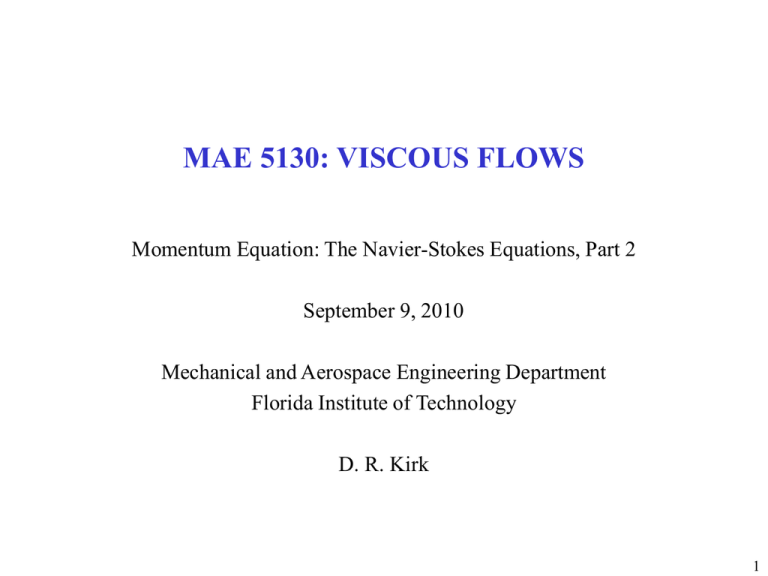
MAE 5130: VISCOUS FLOWS Momentum Equation: The Navier-Stokes Equations, Part 2 September 9, 2010 Mechanical and Aerospace Engineering Department Florida Institute of Technology D. R. Kirk 1 GOAL: INCOMPRESSIBLE, CONSTNAT m N/S EQUATION ma F DV g f surface Dt • Start with Newton’s 2nd Law for a fixed mass • • • • Divide by volume Introduce acceleration in Eulerian terms Ignore external forces Only body force considered is gravity • Express all surface forces that can act on an element – 3 on each surface (1 normal, 2 perpendicular) – Results in a tensor with 9 components – Due to moment equilibrium only 6 components are independent • Employ Stokes’ postulates to develop a general deformation law between stress and strain rate – White Equation 2-29a and 2-29b Assume incompressible flow and constant viscosity DV g ij Dt DV 2 g p m V Dt • 2 TENSOR COMMENT T11 T12 T13 Tij T21 T22 T23 T T 31 32 T33 • Tensors are often displayed as a matrix • The transpose of a tensor is obtained by interchanging the two indicies – Transpose of Tij is Tji T11 T21 T31 T ji T12 T22 T32 T T 13 23 T33 Qij Q ji Rij R ji Tij 1 Tij T ji 1 Tij T ji 2 2 1 1 2 3 42 4 0 5 2 1 3 2 23 2 24 2 0 1 5 2 3 2 1 2 5 1 4 2 2 2 23 3 2 24 2 0 1 5 2 3 2 2 5 1 2 3 • Tensor Qij is symmetric if Qij = Qji • Tensor is antisymmetric if it is equal to the negative of its transpose, Rij = -Rji • Any arbitrary tensor Tij may be decomposed into sum of a symmetric tensor and antisymmetric tensor 1 0.5 1 2 3 1 3 2.5 0 0 2 4 0 5 3 0 3 1 2 1 3 2.5 3 3 0.5 2 0 3 EXAMPLES OF TENSOR PROPERTIES xx ij yx zx xy xz yy yz zy zz I1 xx yy zz I 2 xx yy yy zz zz xx 2 xy xx xy xz I 3 yx yy yz zx zy zz 0 11 0 0 0 22 0 0 33 2 yz 2 zx • Although component magnitudes vary with change of axes x, y, and z, the stress and strain-rate tensor follow the transformation laws of symmetric tensors • 3 invariants are particularly useful • I3 is the determinant • • Another property of symmetric tensors is that there exists one and only one set of axes for which the off-diagonal terms (the shear-strain rates in this example) vanish. These are called the principal axes • Invariants for principal axes I1 11 22 33 I 2 11 22 22 33 33 11 I 3 11 22 33 4 COMMENT ON NOTATION • Recall that in White’s nomenclature: – x1, y1, and z1 are principal axes – x, y, and z are arbitrary axes xx 11l12 22m12 33n12 xx 11l12 22m12 33n12 xy 11l1l2 22m1m2 33n1n2 xy 11l1l2 22m1m2 33n1n2 • With respect to principal axes • x-axis has directional cosines: l1, m1, and n1 • y-axis has directional cosines: l2, m2, and n2 • z-axis has directional cosines: l3, m3, and n3 • Using tensor transformation from principal to arbitrary axes we arrived at general expressions for diagonal and off-diagonal terms for shear stress and strain in arbitrary orientation 5 COMMENTS FROM SECTION 2-4.2 • Simplest assumption for variation between viscous stress and strain rate is a linear law – Satisfied for all gases and most common liquids Stokes’ 3 postulates 1. Fluid is continuous, and its stress tensor ij is at most a linear function of strain rates ij 2. Fluid is isotropic – Properties are independent of directions (no preferred direction) – Deformation law is independent of coordinate system choice – Also implies that principal stress axes be identical with principal strain-rate axes 3. When strain rates are zero (for example if fluid is at rest, V=0), deformation law must reduce to hydrostatic pressure condition, ij = -pdij • Begin derivation of deformation law with element aligned with principal axes – White notation for principal axes: x1, y1, z1 – Axes where shear stresses and shear strain rates are zero 6 FORMULATING THE DEFORMATION LAW 11 p C1 11 C2 22 C3 33 C 2 C3 If V 0, 11 p 11 p K 11 C2 11 22 33 11 p K 11 C2 V K C1 C2 • Using the principal axes the deformation law could involve 3 linear coefficients • Isotropic condition requires that 22 = 33 (cross-flow terms) be equal • -p is added to satisfy hydrostatic condition • Re-write with gradient of velocity • Try to write 22 and 33 terms 7 FORMULATING THE DEFORMATION LAW • Examples of general deformation law p K xx C2 V xx xy K xy • Comparing with shear flow between parallel plates • ui u j d ij V ij pd ij m x x j i Often called the ‘second coefficient of viscosity’ or coefficient of bulk viscosity or Lamé’s constant (linear elasticity) – Only associated with volume expansion through divergence of velocity field DV g ij Dt Now substitute into Newton’s 2nd Law Note that shear stresses are expressed as velocity derivatives as desired K 2m C2 • • 8 THE NAVIER-STOKES EQUATIONS 9 N/S EQUATION FOR INCOMPRESSIBLE, CONSTANT m FLOW ma F DV g f surface Dt • Start with Newton’s 2nd Law for a fixed mass • • • • Divide by volume Introduce acceleration in Eulerian terms Ignore external forces Only body force considered is gravity • Express all surface forces that can act on an element – 3 on each surface (1 normal, 2 perpendicular) – Results in a tensor with 9 components – Due to moment equilibrium (no angular rotation of element) 6 components are independent) • Employ a Stokes’ postulates to develop a general deformation law between stress and strain rate – White Equation 2-29a and 2-29b Assume incompressible flow and constant viscosity DV g ij Dt DV 2 g p m V Dt • 10
